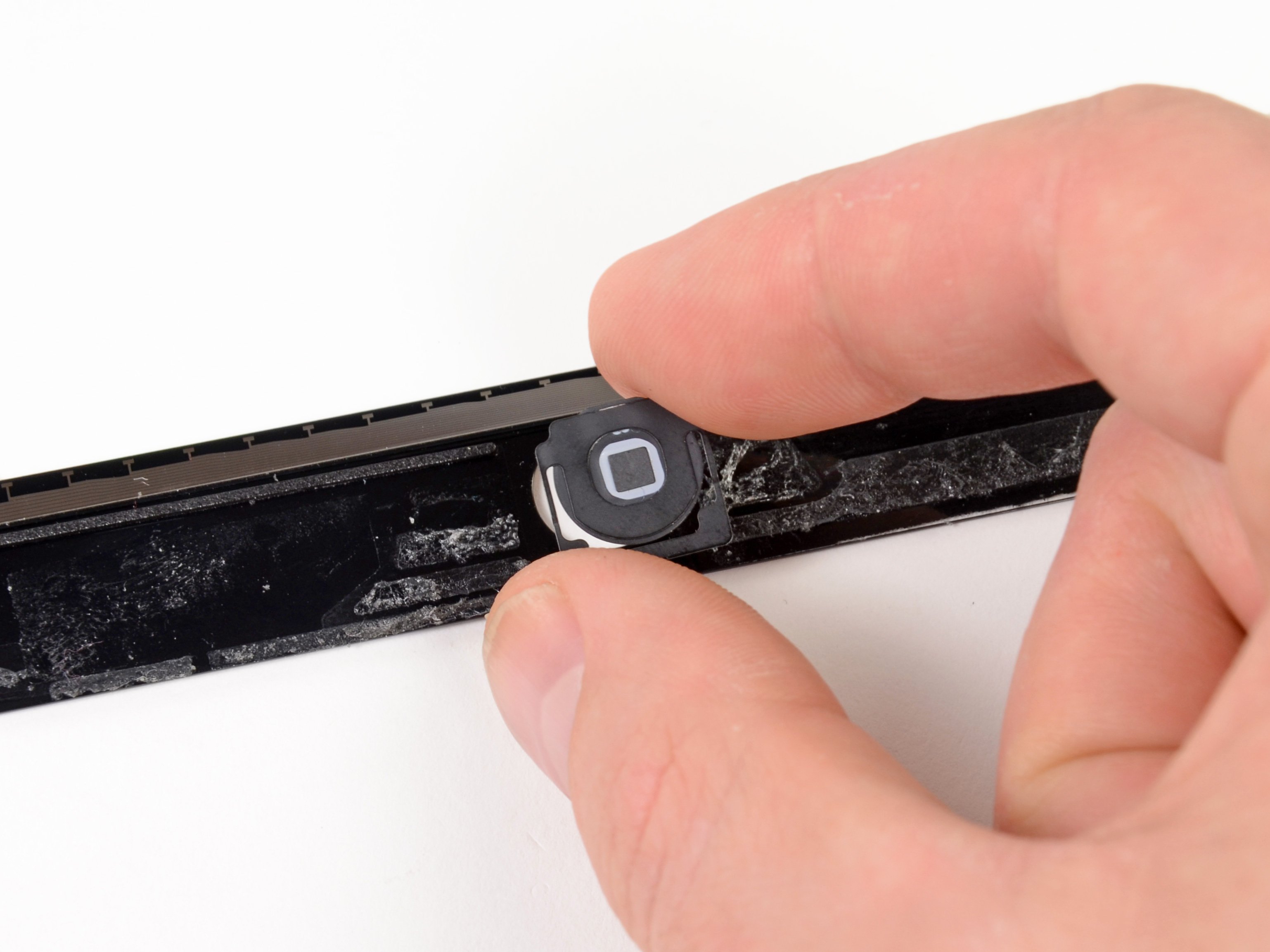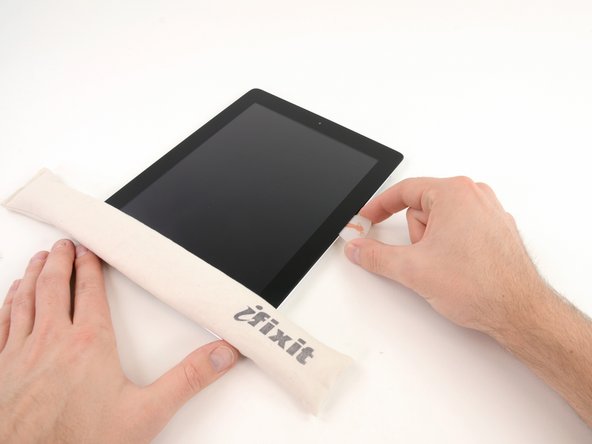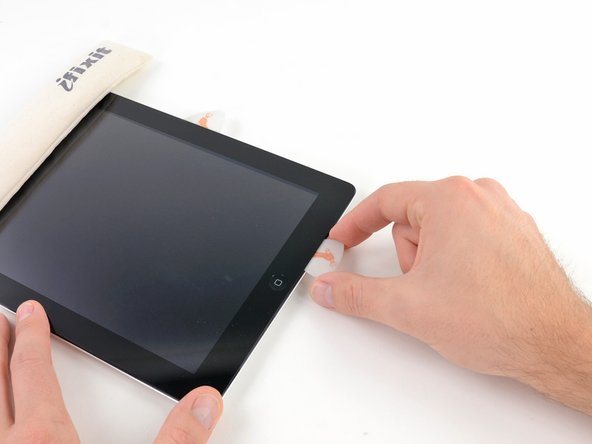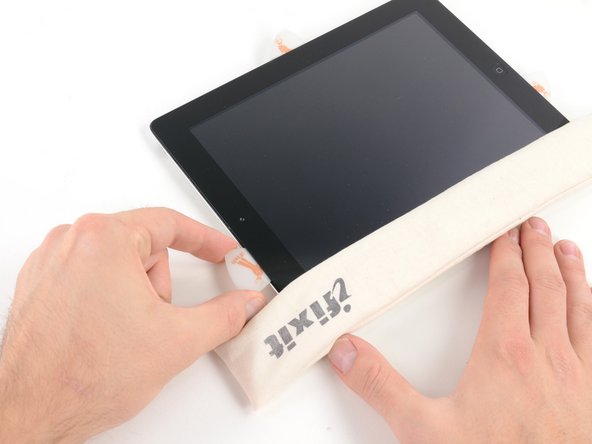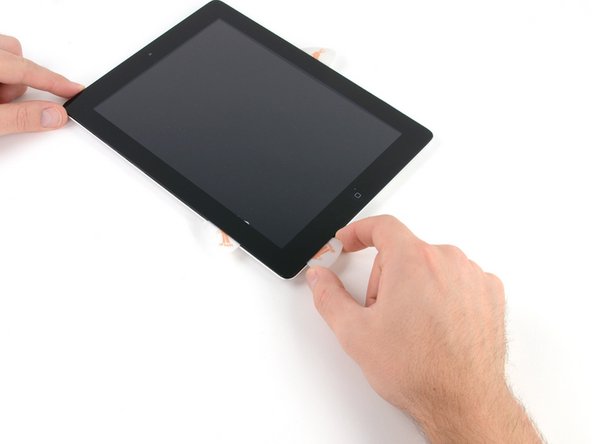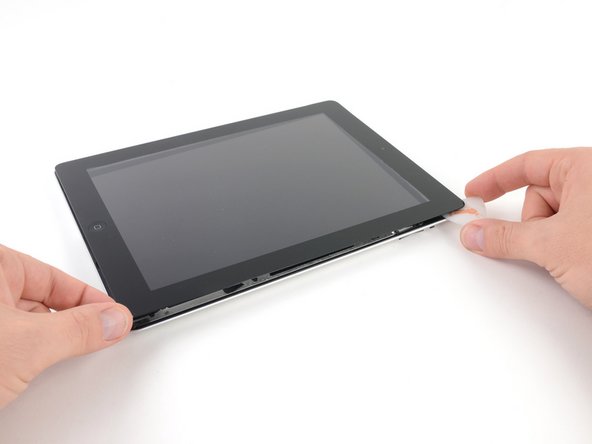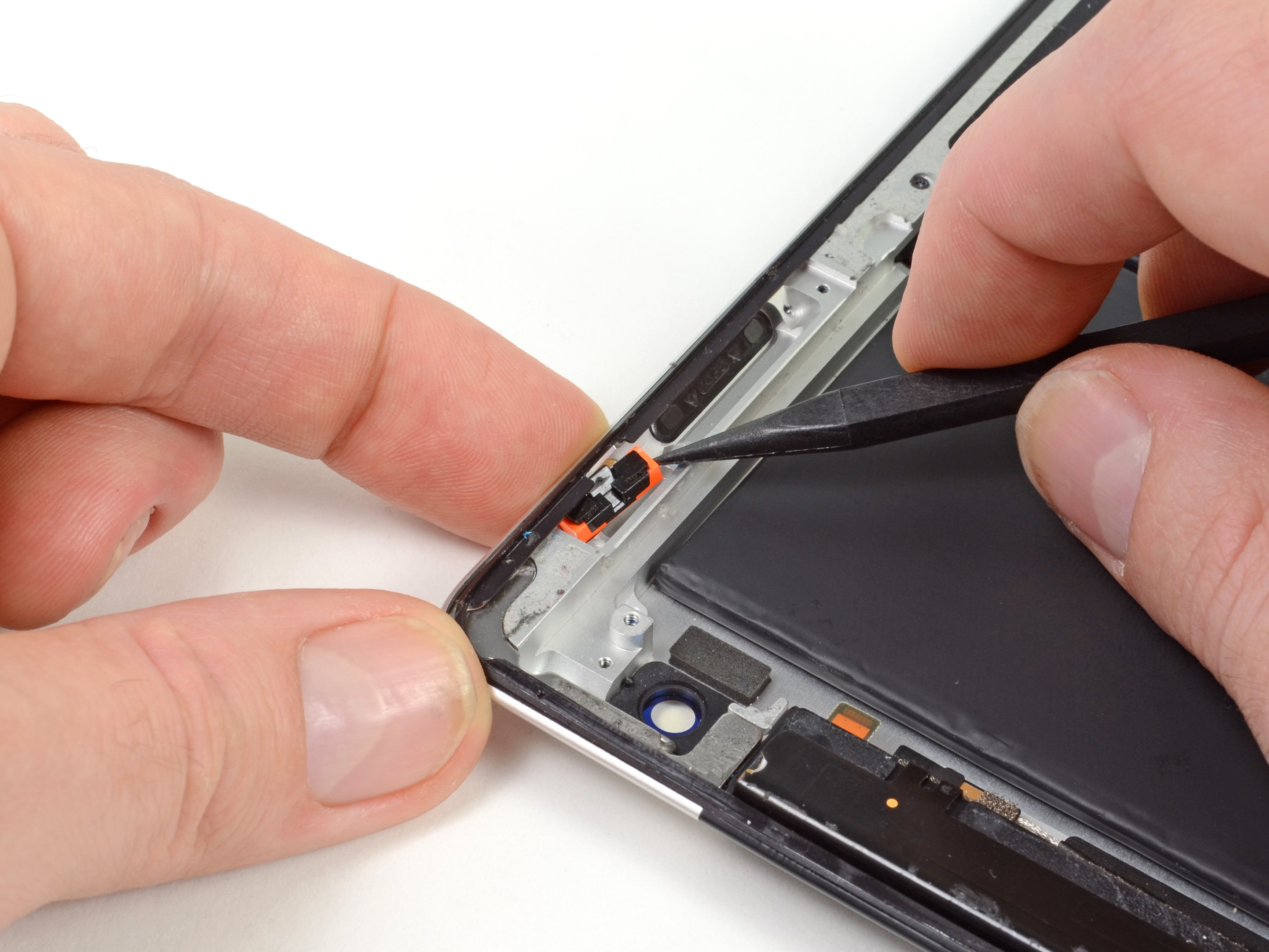iPad 3 4G Home Button Assembly Replacement
Duration: 45 minutes
Steps: 41 Steps
Ready to bring your home button back to life? This guide will walk you through the process of replacing the home button assembly, step by step. If you're feeling unsure at any point, don’t hesitate to schedule a repair. Let’s get that button working like new!
Step 1
For carousel microwaves: Double-check that the plate spins smoothly. If your iOpener gets stuck, it could overheat and cause a burn, so keep it moving!
Before you get started, give your microwave a quick clean. Any leftover gunk on the bottom could end up sticking to your iOpener, making things a bit messier than they need to be.
- Pop the iOpener right in the middle of the microwave.
Tools Used
Step 2
Keep an eye on your iOpener and don’t let it overheat—too much heat could make it go boom. Aim for no more than 100˚C (212˚F) and you’ll be golden.
If the iOpener looks like it’s puffed up, don’t touch it. Just leave it be and let it cool off.
If it’s still a bit too hot to handle in the middle, let it cool down before giving it another go. A perfectly heated iOpener should stay warm for about 10 minutes, so you’ve got some time to work with.
Microwave power varies, so adjust the heating time accordingly. Your iOpener is ready when it feels just a tad too warm to keep your finger on it comfortably.
- Pop the iOpener in the microwave for about thirty seconds to get it nice and warm.
- If it cools down while you’re working, just zap it again in the microwave for another thirty seconds to keep things toasty.
Tools Used
Step 3
The iOpener is going to be pretty hot, so handle with care! Oven mitts are your best friend here—use them if you need to!
- Carefully take the iOpener out of the microwave by grabbing one of the two flat ends—steer clear of the hot middle part!
Tools Used
Step 4
Heads up! The iOpener heats up like a mini sun, so make sure to grab it only by the cooler end tabs to keep your fingers safe.
No microwave? No problem! Just heat your iOpener by placing it in some hot boiling water. Keep an eye on it, and you're good to go!
- Grab a pot or pan and fill it with enough water to completely cover your iOpener.
- Bring the water to a boil, then turn off the heat—no need to keep it bubbling.
- Carefully dunk the iOpener into the hot water for 2-3 minutes, making sure it’s fully soaked.
- Use tongs to lift the iOpener out of the water—watch those fingers!
- Give the iOpener a good dry-off with a towel so it’s ready to work its magic.
- Ready to go! If you need to warm it up again, just repeat the boil, off-heat, soak routine for 2-3 minutes.
Tools Used
Step 5
Pop on some safety glasses to keep those peepers safe, and handle that LCD screen with care—it's delicate, just like you!
This will help keep those pesky glass shards in check and make sure the display stays solid while you're carefully prying and lifting it.
- Got a cracked display? No worries, let's keep it under control and avoid any mishaps. Use some clear packing tape to keep the glass from shattering further and to stay safe while you're at it.
- Start by laying down overlapping strips of clear packing tape over the iPad’s display, covering the whole front. It might not be the most glamorous look, but it works!
- Follow the rest of the guide, but keep in mind that once the glass is cracked, it might keep breaking as you go. If it does, grab a metal prying tool to help lift the pieces out, and don’t sweat it—you’ve got this!
Step 6
Just a heads-up: since you might encounter some broken glass during this repair, it’s a good idea to wear safety glasses. Better safe than sorry when those shards start flying!
- Place the iOpener gently on the right edge of the iPad, making sure it's nice and flat so it’s making good contact with the surface. We want maximum warmth for this part.
- Let the iOpener sit there for around 90 seconds, giving it some time to work its magic before you go ahead and try to open the front panel.
Tools Used
Step 7
It might take a little extra effort to slide the opening tool between the glass and plastic. Take your time, and gently wiggle the tool back and forth to help loosen things up. Patience is key here!
- Spot a tiny gap in the iPad's adhesive ring at the upper right corner, about 2.0 inches (~5 cm) down from the top edge. This little opening is your secret entry point.
- Line up your tool with the mute button and gently slip the tip of a plastic opening tool into the crack between the front glass and plastic bezel. Just a quick nudge with the very tip to widen the gap—no need to force it.
Step 8
- Be sure to position the tool just right—snugly between the plastic display bezel and the front panel glass.
Step 9
- Slide the plastic opening tool's tip into the gap between the front glass and plastic bezel, then gently slide a plastic opening pick in right next to it. Keep it snug in place as you move along, like you're tucking in a blanket!
Step 10
- Take out the plastic opening tool from your iPad, and slide the opening pick a little deeper underneath the front glass, aiming for a depth of about half an inch. Keep it steady and gentle, you got this!
Step 11
- As you carefully loosen the adhesive along the right edge of the iPad, go ahead and warm up the iOpener again, then place it back along the bottom edge to keep things nice and toasty.
Tools Used
Step 12
This adhesive is no joke—it's super strong and might need some serious muscle. Take it slow and steady!
If the tip of your opening pick peeks out from under the front glass, just give it a little tug back. Going this deep with the pick won’t cause damage, but it might leave some sticky adhesive smudges on the LCD.
- As the iOpener warms up the bottom edge, start gently loosening the adhesive along the right side of your iPad.
- Carefully slide the opening pick down the edge, easing the adhesive away bit by bit.
Tools Used
Step 13
If the adhesive doesn't come off as easily as you'd like, try moving the heated iOpener back to the right edge of the iPad. This is especially helpful if the iPad's had some time to cool off while you were busy with other steps. It’s all about getting that perfect adhesive release, so feel free to give it a little extra heat if needed!
- If the opening pick is giving you trouble and gets caught in the adhesive, just gently roll it along the side of the device to help loosen the adhesive and keep things moving.
Tools Used
Step 14
- Before pulling out the first opening pick from the bottom corner of your iPad, slide a second pick under the right edge of the front glass to keep that stubborn adhesive from sticking back together.
- Warm up the iOpener again, then shift it to the top edge of the iPad to keep things nice and toasty.
Tools Used
Step 15
The Wi-Fi antenna is hanging out on the bottom right edge of the iPad’s rear case, secured by screws and a cable. Since it’s chilling at a tricky angle, take your time and handle it gently to avoid any accidental damage that can’t be fixed.
- Alright, you're about to dive into some precision work here, so make sure you're ready to go slow and steady.
- Next up, you're going to need to carefully release the adhesive that's holding the antenna to the front panel. Just be super mindful of the delicate connections on the bottom of the iPad — they're easy to damage, and we don't want that! Take your time, and you'll do just fine.
Step 16
Keep the pick from sliding past the bottom right corner—going further might mess up the Wi-Fi antenna, and we definitely don’t want that!
- Gently slide the opening pick along the bottom right corner of your iPad to release that sticky adhesive. Keep it smooth and steady—this step is key to getting things opened up cleanly!
Step 17
Take it slow and steady when you move the opening pick along the bottom right edge of the front panel. There's a sneaky Wi-Fi antenna hiding close to the corner, and if the adhesive isn't handled just right, it could get cut. So, be gentle, and keep an eye on that corner!
Keep the pick gently tucked under the front glass—don’t pull it all the way out! Just slide it back a bit so about 1/8" (3 mm) of the tip stays cozy underneath the glass.
- Gently glide the tip of your opening pick along the bottom edge of the iPad. You'll be loosening the adhesive near the Wi-Fi antenna, so take it slow and steady!
Step 18
- After you pass the Wi-Fi antenna (about 3" or 75 mm from the right edge, right next to the home button), slide the opening pick all the way in.
- Gently slide the pick to the right to loosen the adhesive holding the Wi-Fi antenna to the front glass.
- The antenna is secured to the bottom of the iPad with screws and a cable. This step carefully separates the antenna from the front panel so it stays safe when you remove the panel.
Step 19
Keep your iOpener chill—heat it for no more than a minute, then give it a couple minutes to cool down before the next round.
If the adhesive has cooled down a bit too much along the bottom edge, just give the iOpener a quick reheat to warm things up again where you're working. That should do the trick!
- Keep sliding that opening pick along the bottom edge of the iPad, carefully pulling it out just enough to navigate around the home button. Once you’re past it, tuck the pick back in about 1/2 inch (10 mm) deep and keep going!
Tools Used
Step 20
When working on iPad 4 models, carefully insert the pick no more than 1/2 inch (10 mm) deep in this area. This will keep you clear of the home button ribbon cable and avoid any mishaps!
- Gently peel back the adhesive along the bottom edge of the iPad, taking your time to avoid any rush.
- Keep that trusty opening pick in place under the front glass, just near the home button, for that extra stability.
Step 21
- Pop the iOpener back in the microwave for a quick warm-up, then place it on the left edge of the iPad to gently heat the adhesive in that spot.
Tools Used
Step 22
If the adhesive's gotten too cool, just pop the iOpener back along the top edge and keep going. If it's cooled down too much, give it another heat-up and carry on.
- Start by sliding the opening pick along the top edge of the iPad. Gently pull it out as you go around the front-facing camera bracket. Take it slow, and you'll get there!
- The adhesive in this area can be pretty stubborn, so you might need to apply some muscle. Just go carefully and don’t rush—no need to hurt yourself or your iPad!
- If the pick gets caught in the sticky stuff, try rolling it like shown in step 9. That should help you get through it a little easier.
Tools Used
Step 23
If the adhesive has warmed up nicely, go ahead and remove the iOpener from the iPad to make your life easier. But, if it's still being a little clingy, just heat it up again and let it chill on the left edge while you get down to business.
- Keep peeling the adhesive along the top of the iPad, then carefully slide your opening pick around that top left corner like a pro.
Tools Used
Step 24
The digitizer cable hangs out about 2" (50 mm) up from the bottom of the iPad. When sliding your pick, ease off once you hit around 2.25" (60 mm) from the bottom to keep things safe and sound.
- Gently slide the opening pick along the left edge of your iPad, carefully loosening the adhesive as you go. The adhesive is super thin here because of the digitizer running along the entire left side—so keep the pick shallow (no deeper than 10 mm or about half an inch) to avoid any accidental damage.
Step 25
Heads up! The bottom of the digitizer cable is just about an inch (25 mm) from the iPad’s bottom edge. Take it slow and steady—let’s keep that cable safe and sound!
- Now, using the trusty opening pick that's still hanging out under the bottom edge of your iPad, carefully loosen up the adhesive in the bottom left corner. Take your time—this part is key to getting everything off smoothly!
Step 26
Sometimes the adhesive around the edge of the iPad decides to play sticky again. If that happens, just slide a pick under the spot where the front glass is still holding on and gently 'cut' through the adhesive to free it up.
- Grab one of your trusty opening picks and gently wedge it under the bottom right corner of the iPad, then lift it up and hold on tight with your fingers.
Step 27
Watch out for any leftover adhesive that's still sticking around! Grab an opening pick and gently slice through any stubborn adhesive that's keeping the front panel in place.
- Grab your iPad by the top and bottom right corners and gently twist the front glass away from the body. Take it slow, no need to rush this part!
- When you're putting everything back together, make sure to give that LCD a good clean with a microfiber cloth and a puff of compressed air. Get rid of any dust or fingerprints before you seal it up—your screen deserves to shine!
Step 28
- Unscrew the four tiny 2 mm Phillips #00 screws holding the LCD onto the aluminum frame—think of it as gently freeing a trapped treasure!
Step 29
Handle the LCD gently as you move it. The ribbon cable is delicate and could snap if bent too much.
- Grab a plastic opening tool or spudger and gently pry up the right edge of the iPad’s LCD.
- Carefully swing the LCD up along its left side and let it rest on top of the front panel.
Tools Used
Step 30
- Take the spudger and carefully use the tip to peel back the tape that’s holding the LCD ribbon cable connector in place. Nice and easy, no rush!
Tools Used
Step 31
- Gently lift the retaining flap on the LCD ribbon cable ZIF connector.
- Carefully pull the LCD ribbon cable out of its socket on the logic board using your fingers or tweezers.
- If the screen doesn't power on after reconnecting the ZIF connector, try force restarting your device. Just hold down the power and home buttons for about ten seconds until the Apple logo appears.
Step 32
- Carefully lift the LCD off the front panel, making sure to avoid touching the front of the screen.
Step 33
- Gently use the tip of a spudger to lift and peel back the tape holding the touchscreen ribbon cable to the logic board. Take it slow and steady—you've got this!
Tools Used
Step 34
- Gently lift the little flap holding down both touchscreen ribbon cable ZIF connectors—think of it like opening a tiny door to freedom!
Step 35
- Gently use the flat end of a spudger to lift the adhesive that's holding the digitizer ribbon cable in place.
- Now, carefully pull the digitizer ribbon cable out of its sockets on the logic board. Don't force it; it should come out smoothly!
Tools Used
Step 36
- Gently peel back the touchscreen ribbon cable, then use the flat end of a spudger to carefully free the adhesive holding the cable to the aluminum back case.
Tools Used
Step 37
- Gently wiggle and pull the touchscreen ribbon cable out from its cozy spot in the aluminum frame using your fingers.
- Lift the front panel off the iPad carefully and set it aside.
Step 38
Take care not to heat the iOpener too much during your repair. We suggest giving it a solid three-minute chill time before warming it up again.
The home button assembly sticks to the front panel with some adhesive. Warming things up a bit with an iOpener to loosen the glue is a smart move.
- Heat up the iOpener by popping it in the microwave for 30 seconds on the highest power—just enough to soften it up.
- Set the warm iOpener right over the home button at the front edge of the screen to get things ready.
Tools Used
Step 39
- Slide the plastic opening tool under the right side of the home button assembly and gently pry upward to break the adhesive seal on that side.
Step 40
- Apply the same method as before to gently free the adhesive holding the left side of the home button in place.
- Carefully lift the home button mount away from the front panel.
Step 41
- Gently wedge the edge of your plastic opening tool under the home button bracket. Give it a little nudge!
- Now, slide that plastic tool along the spring bracket to loosen the adhesive. Smooth moves will make this easy.
- Carefully lift the home button with the bracket off the front panel. It's free! If you're stuck, don't hesitate to schedule a repair for a helping hand.
